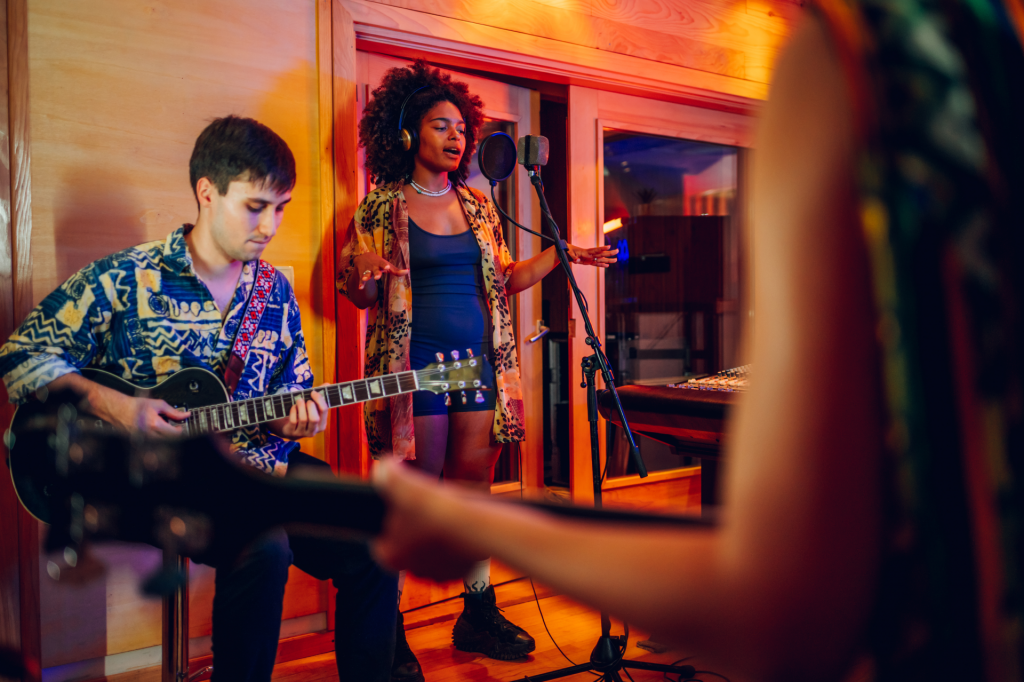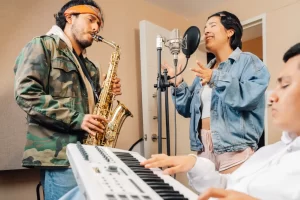Indie music, a term that originated from “independent,” stands as a testament to the creativity and self-expression that thrives outside the conventional boundaries of the mainstream music industry. Rooted in a DIY ethos, indie music encompasses a diverse array of genres, from rock and folk to electronic and beyond, all unified by their departure from major label control. This genre has evolved significantly since its inception, tracing back to the late 20th century when artists and bands began to record, produce, and distribute their music independently, seeking artistic freedom and authenticity.
Today, indie music not only represents a specific sound or style but also a broader cultural movement that values artistic integrity over commercial success. It has carved out its own niche, influencing fashion, lifestyle, and even mainstream music itself. As we delve into the essence of indie music, we uncover the rich history, distinct characteristics, and the dynamic, ever-changing scene that continues to captivate listeners worldwide. This exploration is not just about understanding what indie music is, but also appreciating its impact on the musical landscape and how it continues to challenge and redefine the boundaries of creativity.
The Roots of Indie Music
The roots of indie music are as diverse and eclectic as the genres it encompasses today. Its origins can be traced back to a time when artists, operating outside the confines of major record labels, began to forge their own paths in the music industry. This movement was born out of a desire for creative freedom, a rejection of commercial pressures, and a commitment to artistic integrity. Pioneering artists and bands of the 1970s and 1980s laid the groundwork for what would become the indie music ethos. They embraced a do-it-yourself (DIY) approach to recording, producing, and distributing their work, often releasing music on their own or through independent labels.
This era was characterized by a vibrant underground music scene, with live venues, independent record stores, and college radio stations playing pivotal roles in the promotion and dissemination of indie music. The punk rock movement, with its raw sound and rebellious spirit, significantly influenced the indie scene, instilling a sense of autonomy and resistance against the commercial music industry. As indie music evolved, it absorbed elements from various genres, including folk, post-punk, and alternative rock, further enriching its diversity and appeal.
The defining characteristic of indie music’s early days was not a specific sound but a shared ethos: a commitment to independence, authenticity, and a community-oriented approach to music-making. This foundation allowed indie music to flourish into a broad, inclusive category that continues to defy easy categorization, welcoming artists who seek to express themselves freely, without the constraints imposed by traditional music industry models.
Characteristics of Indie Music
Indie music, with its rich tapestry of sounds and styles, is characterized by its diversity and the ethos of independence that underpins it. This genre is not confined to a singular musical style; instead, it spans a spectrum that includes rock, pop, electronic, folk, and beyond. What binds these varied sounds together is not a specific sonic signature, but a shared commitment to artistic freedom and authenticity. This freedom allows indie artists to experiment with their music, often leading to innovative and genre-defying sounds.
A common thread among indie music is the emphasis on creative songwriting and storytelling. Lyrics in indie tracks frequently explore personal, social, and existential themes, often with a depth and introspection that set them apart from more mainstream offerings. The storytelling aspect of indie music is reflective of its artists’ desire to connect with listeners on a more personal and emotional level, unfiltered by commercial constraints.
Another defining characteristic of indie music is its DIY ethic, a principle rooted in the genre’s origins. This ethic extends beyond music production to include self-management, self-promotion, and distribution, embodying a holistic approach to independence. The DIY culture fosters a close-knit community among artists, fans, and independent labels, creating a supportive ecosystem that values music as an art form over its commercial potential.
The indie music scene is also known for its authenticity and the intimate connection artists maintain with their audience. Indie musicians often engage with their fans in a direct and personal manner, whether through live performances in smaller, more intimate venues or through social media and other digital platforms. This authenticity and direct engagement are key to the indie music experience, emphasizing the personal connection between artist and listener over the impersonal nature of mass-market entertainment.
The Indie Music Scene Today
The indie music scene today is a vibrant and sprawling ecosystem, thriving more than ever thanks to the advent of digital technology and the internet. The barriers to entry that once defined the music industry have been significantly lowered, allowing a wider array of artists to produce, distribute, and promote their music on a global scale. Platforms like Bandcamp, SoundCloud, and Spotify have become instrumental in indie artists reaching audiences far beyond their local scenes, democratizing music distribution and discovery.
This digital revolution has also fostered a sense of community and collaboration among indie musicians and fans alike. Social media and streaming services have enabled artists to share their stories, connect with listeners, and build dedicated fanbases without the need for traditional marketing or record label support. These platforms have not only facilitated a more direct artist-to-listener relationship but have also allowed indie music to permeate mainstream culture in unprecedented ways.
Despite the increased accessibility and visibility, the indie music scene retains its core ethos of independence and authenticity. Many artists continue to operate under DIY principles, even as they gain popularity. The scene is characterized by a diverse array of genres and subcultures, each with its own communities and fanbases. Live music, too, remains a crucial aspect of the indie experience, with festivals and venues dedicated to indie and alternative music serving as key hubs for live performances, networking, and discovery.
The indie music scene’s adaptability and resilience are evident in its response to the challenges posed by the digital age. Artists and labels are finding innovative ways to sustain themselves financially while preserving their independence and creative freedom. Crowdfunding, merchandise sales, and direct-to-fan sales are just some of the strategies being employed to support the creation and distribution of indie music. As the scene continues to evolve, its spirit of innovation and community ensures that indie music remains a vital and dynamic force in the wider musical landscape.
Impact of Indie Music
The impact of indie music extends far beyond its own diverse scene, influencing mainstream music, culture, and even societal values. Its ethos of creativity, authenticity, and independence has challenged the traditional music industry, pushing major labels and mainstream artists to adopt more innovative and authentic approaches. Indie artists, often seen as trendsetters, have introduced new sounds and ideas into the mainstream, demonstrating that music can thrive outside the commercial model. This has led to a blurring of lines between the indie and mainstream sectors, with indie music becoming a significant source of innovation and diversity in the wider music landscape.
Culturally, indie music has played a pivotal role in shaping contemporary fashion, art, and lifestyle, reflecting and influencing youth culture and trends. The indie ethos, with its emphasis on authenticity and self-expression, resonates with a broad audience, particularly among younger generations who value individuality and authenticity. This cultural impact is evident in everything from fashion choices to the rise of independent coffee shops and bookstores that often become social hubs for the indie community.
Indie music’s influence also extends to social and political realms. Many indie artists use their platform to address social issues, advocate for change, and encourage critical thought among their listeners. This has fostered a community of fans who are not only passionate about music but also engaged with wider societal issues, illustrating how indie music can inspire and mobilize individuals towards greater awareness and action.
Moreover, the success of indie music has demonstrated the viability of alternative economic models in the arts, encouraging artists across disciplines to pursue independent paths. The growth of the indie music scene has shown that with creativity, passion, and community support, artists can achieve success on their own terms, challenging conventional wisdom about success in the arts and entertainment industry.
Challenges Facing Indie Music
Despite its successes and influence, the indie music scene faces several challenges in the modern digital landscape. One of the most pressing issues is the financial sustainability of independent artists. Without the financial backing of major labels, indie musicians often struggle to cover the costs of production, distribution, and promotion. The proliferation of streaming services, while providing unprecedented access to audiences, has also made it difficult for artists to generate substantial revenue from their music alone. The low payout rates of streaming platforms mean that artists must find alternative revenue streams, such as live performances, merchandise, and direct sales, to sustain their careers.
Another significant challenge is the saturation of the music market. The same digital platforms that have democratized music distribution have also led to an overwhelming amount of content being released. This makes it increasingly difficult for indie artists to stand out and reach potential fans. The competition is not just with other indie musicians but also with mainstream artists who have more resources for marketing and promotion.
Furthermore, the reliance on social media and digital platforms for promotion presents its own set of challenges. Algorithm changes can drastically reduce visibility, and the constant need for content creation can be daunting for artists who prefer to focus on their music. The digital landscape requires indie musicians to be not only artists but also marketers and content creators, a dual role that can be both time-consuming and creatively draining.
Lastly, the live music scene, a crucial aspect of indie music’s ecosystem, has faced its own challenges, including venue closures and the impact of global events such as the COVID-19 pandemic. These challenges have disrupted traditional revenue and exposure opportunities, forcing artists and the industry to adapt to new models of engagement and performance. Despite these hurdles, the indie music scene continues to innovate and thrive, driven by its core ethos of creativity, community, and independence.
The Future of Indie Music
The future of indie music, while facing challenges, is marked by resilience and innovation. As the digital landscape continues to evolve, indie artists and labels are finding new ways to adapt and thrive. Emerging technologies, such as blockchain and NFTs (non-fungible tokens), offer potential for artists to monetize their work directly and establish deeper connections with their fans. These technologies could redefine music ownership and revenue models, giving indie artists more control over their work and ensuring fair compensation.
Furthermore, the rise of niche online communities and platforms provides indie musicians with targeted channels to reach and engage with their audiences. These spaces offer opportunities for artists to cultivate dedicated fanbases, bypassing the need for mainstream recognition. The trend towards personalization and curated experiences in music consumption aligns with the strengths of indie music, emphasizing authenticity and connection.
The environmental consciousness and social awareness of younger generations also bode well for the indie music scene. As listeners increasingly seek out music that aligns with their values, indie artists, known for their authenticity and often socially conscious lyrics, are well-positioned to resonate with these audiences.
Live performances, a cornerstone of indie music, are expected to remain vital, with a shift towards more intimate and immersive experiences. Post-pandemic, there’s a growing appreciation for the communal aspect of live music, which could lead to a resurgence of small venues and DIY spaces that are the lifeblood of the indie scene.
The future of indie music lies in its ability to leverage new technologies, embrace direct-to-fan engagement models, and maintain its core values of authenticity and independence. Despite the obstacles, the indie music scene is poised for continued innovation, offering a dynamic and inclusive alternative to the mainstream music industry.
To Sum It Up
To sum it up, indie music embodies a spirit of creativity, authenticity, and resilience that has profoundly impacted the music industry and culture at large. Rooted in a desire for artistic freedom and a DIY ethos, indie music has evolved from an underground movement to a diverse and influential scene. Its journey reflects the challenges and opportunities presented by the digital age, demonstrating the enduring appeal of music created outside the mainstream’s constraints.
The indie music scene today, vibrant and dynamic, continues to innovate and adapt in the face of financial and technological challenges. It offers a platform for artists to express themselves authentically, connect with like-minded communities, and explore new models of creativity and distribution. The impact of indie music extends beyond its own boundaries, influencing mainstream music, fashion, and social values, and fostering a culture that values individuality and critical thought.
Despite the hurdles, the future of indie music looks promising, driven by technological advancements, changing listener preferences, and the unwavering passion of indie artists and fans. The essence of indie music—its commitment to independence, creativity, and community—ensures that it will continue to thrive and inspire, shaping the musical landscape in unpredictable but invariably enriching ways.
In essence, indie music is not just a genre; it’s a testament to the power of music to connect, challenge, and change. As we look forward, the indie scene stands as a beacon for aspiring artists and a reminder that music’s heart beats strongest in the spaces between the notes, in the stories untold, and in the voices yet to be heard.




